
Mira Adler-Gillies at the ABC looks at How deadly is 50-degree heat? Australia’s cities face the new reality of climate change:
- Buckled train tracks, grounded planes, melting bitumen and massive blackouts: the dystopian vision of the 50-degree city is closer to reality every day.
With wildfires raging around the Arctic Circle, unprecedented heatwaves in the Northern Hemisphere and record temperatures being set from Algeria to Canada, the world is getting inexorably hotter.
We don’t know how well cities will cope in extreme heat. Sydney and Melbourne both have records hovering around 46 degrees. During last year’s warm winter over 260 heat and low rainfall records were broken. A study led by Dr Sophie Lewis projected daily temperatures of up to 3.8 degrees Celsius above existing records in Victoria and New South Wales.
- “One of the hottest years on record globally in 2015 could be an average year by 2025,” she said.
Infrastructure can be affected. Marco Amati from RMIT University remembers toward the end of the Millennium drought seeing railway workers in Melbourne spraying railway tracks to try to keep them cool because they were bending out of shape.
Fossil electricity is apt to fail. In February 2017 some 14% of gas and coal generation failed during the heatwave when we needed them most. On 28 September this year Giles Parkinson wrote that so far this year, the big coal and gas generators have tripped more than 100 times.
Also:
-
In the US… in any temperature that is above 110F [43.33°C], planes cannot fly because … the density of the air is not sufficient for these planes to take off.”
However, extremes can kill as there is a threshold, with some individual variation, at which heat becomes deadly. The Mira Adler-Gillies article tells how the lining of the gut breaks causing blood poisoning, so that immune system cells attack these particles inside your body, creating coagulations that eventually clog the kidneys and parts of the lungs.
Associate Professor Camilo Mora from the University of Hawai says that by the end of the century over half the world’s population will be exposed to this kind of deadly heat for at least 20 days a year.
For now:
- In July this year a heatwave that swept across Quebec in Canada killed over 90 people in just over a week.
That pales in comparison to the more than 60,000 heat-related deaths during Europe’s 2003 heatwave, but heat-related deaths are rising in many parts of the world. Liz Hanna last year in The reality of living with 50℃ temperatures in our major cities notes:
-
Melbourne’s 2014 heatwave triggered a surge in demand for ambulances that greatly exceeded the number available. Many of those in distress waited hours for help, and the death toll was estimated at 203.
This graph shows that deaths from heat were at high levels during the first half of last century, then consistently improved to become almost negligible by 2000:
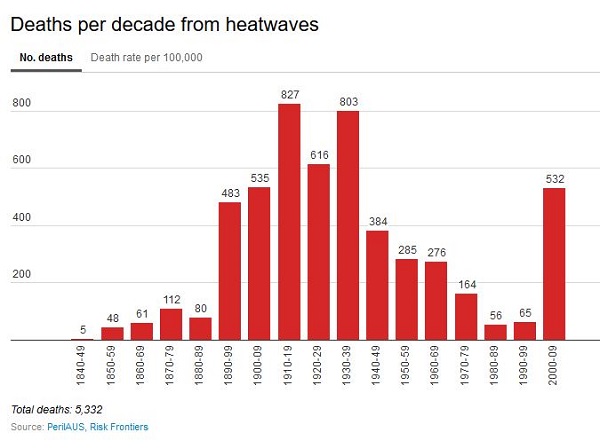
This century they have surged dramatically and most working in the area think they are going to continue to surge from here.
Andrew King in Are heatwaves ‘worsening’ and have ‘hot days’ doubled in Australia in the last 50 years? goes through the statistical mire in answering that question. The short answer is ‘yes’ to both, but ‘hot days’ can be defined in absolute terms or related to the average in the area. This graph show number of days in each year where the Australian area-averaged daily mean temperature is extreme. Extreme days are those above the 99th percentile of each month from the years 1910-2015:
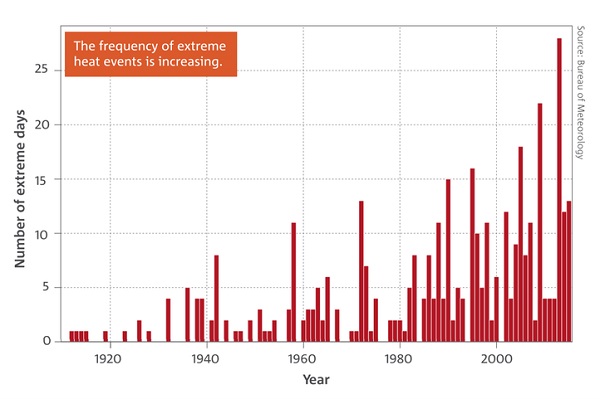
This one shows the decade by decade trend:
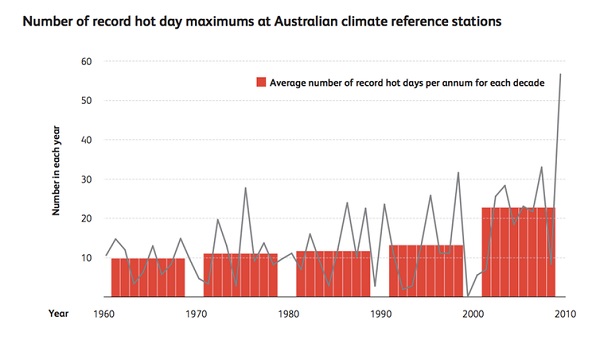
Andrew Gissing and Lucinda Coates ask Australia’s ‘deadliest natural hazard’: what’s your heatwave plan?
They did some research with residents and business managers in Western Sydney and the NSW North Coast finding that:
45% of those at risk – including the elderly, ill and very young – did not proactively respond to heatwave warnings as they did not think it necessary or did not know what to do.
Few at-risk people reported moving to cooler locations, and more than 20% of people in Western Sydney were concerned about the impacts of energy prices on their ability to use air-conditioning.
Nicholas Rajkovich looks at the multiple solutions that should be pursued by American cities to mitigate heatwaves.
Liz Hanna gives us this graph, which shows that heat is more dangerous than cold:
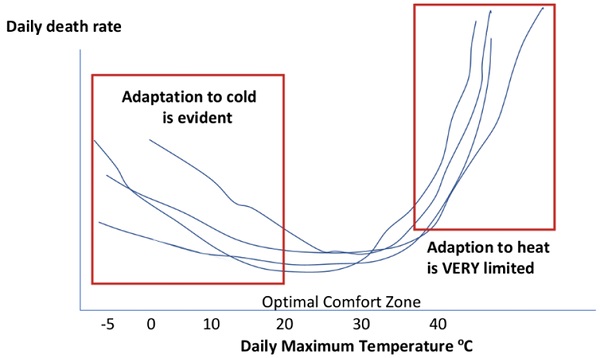
Cold kills, however, and how the equation works out will differ around the world. Daisy Dunne in a fascinating post at Carbon Brief finds that in some countries there will be fewer deaths at 2°C than at 1.5°C:
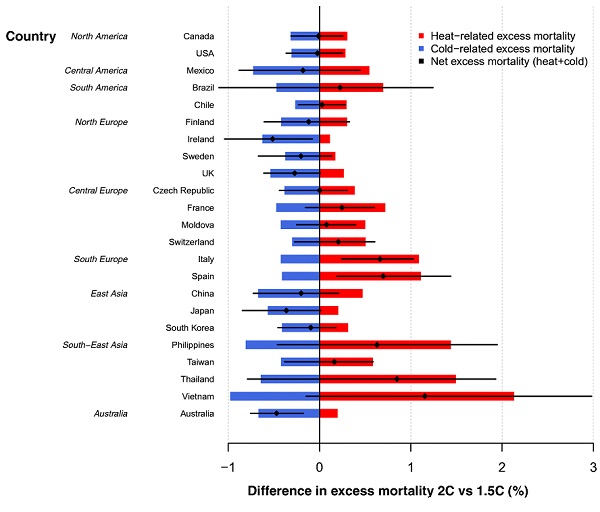
If a diamond is on the right-hand side of the chart, it means the net number of deaths is expected to be lower under 1.5 than 2C. However, if it is on the left-hand side, it shows that the net number of deaths is expected to be higher under 1.5 than 2C for that country.
The only acceptable goal, however, is to return the climate to the condition in which human beings thrived during the last 9,000 years. David Spratt has laid a landmine in front of the IPCC’s report due out this month which is charged with telling us how warming can be limited to 1.5°C.
A number of scientists, including Prof Michael Mann and Prof Stefan Rahmstorf of Germany’s Potsdam University consider that we are now “in a kind of climate emergency” and that at least 1.5°C is “locked in” and could be reached in about a decade’s time. This brings us into the zone where tipping points may move us further, virtually no matter what we do.
James Hansen, former NASA climate science chief and perhaps the world’s best-known climate expert, says getting to 2°C or more would be a “prescription for disaster”, triggering tens of metres of sea-level rise and passing tipping points which could not be reversed on human timescales. In fact, if today’s CO2 level was maintained, it would produce a lot more warming than 1.5°C in the longer term. In the early- to mid-Pliocene 3–4.5 million years ago, CO2 levels were similar to today but temperatures were 3–4°C warmer than pre-industrial values. (Emphasis added)
Clearly climate as we now experience it has become significantly problematic, but we are only experiencing the short-term effects of emission levels already there in the atmosphere.
I’ll take this up in more detail in a subsequent post, but this is alarming:
-
Professor Hans Joachim Schellnhuber, head of the Potsdam Institute for Climate Impact Research, and a senior advisor to Pope Francis, German Chancellor Angela Merkel and the European Union recently argued that “Climate change is now reaching the end-game, where very soon humanity must choose between taking unprecedented action, or accepting that it has been left too late and bear the consequences.”
Meanwhile as a personal anecdote, I remember coming down in a hotel lift in Wellington in January 1981, when my co-passenger said, “Looks like another stinker today!”. The forecast was for a maximum of 22°C.

Posted on yesterday’s online SMH was an article by Peter Hannam headlined ‘Fossil fuels protect us’: Liberal backbencher tells party not to worry about climate, beginning with:
And because humanity is so dependent on finite and rapidly depleting fossil fuels for our energy needs, then we will be in dire circumstances when fossil fuel supplies, particularly petroleum oil and fossil natural gas, begin sustained declines probably before 2030, with a significant risk before 2020.
Kelly and his ilk appear to live in an alternative reality.
Brian,
If I may adapt Harry Truman,
Uff yew carnt take the Wullington heat, jest stay out of their hotel lufts!!
Our NZ cousins have a lot to answer for.
Also posted yesterday on the online SMH was an article by Nichole Hasham headlined Architect of Paris climate accord says Morrison government’s emissions stance is ‘anti-science’, beginning with:
Today at abc.net.au is an article headlined Climate data release again delayed by Government, FOI documents show, beginning with:
It seems as if the federal government is using a well-worn tactic: If a government report finding is inconvenient, sit on it until some other big distraction comes along before releasing it, hoping no one will notice.
Brian,
When outside in the environment, you can always put on more clothes and protective apparel in colder conditions, but there is only so much clothing you can remove in hotter conditions.
New research from an international team of scientists suggests that one of the most tangible impacts may be an increase in suicide rates. The Conversation article, dated Sep 6, includes:
And yet Craig Kelly says we need not worry about climate change: “we are so safe”.
Geoff M, thanks for the climate data release link. I heard the ACF comment on the radio today.
At last, some rain for inland NSW.
Cheerio
BTW
A long piece in the New York Times about a Mr Murnane of Goroke in the Wimmera, who might be the “next winner of the Nobel Prize in Literature whom you had never heard of”.
What about Les Murray??
SMH‘s Environment Editor, Peter Hannam, posted yesterday afternoon, has an op-ed headlined Australians the frog in the saucepan as world warms up.
Also posted yesterday by Peter Hannam is another article headlined Coal binge puts Paris climate targets further out of reach, study finds, which includes:
And SMH‘s environment and energy correspondent, Nichole Hasham, posted earlier today an article headlined Documents show Australian and South Korean officials discussed financing Adani mega-mine, which begins with:
Posted two days ago at The Guardian is the first of a new series on The new normal? How climate change is making droughts worse, by Nick Evershed, Andy Ball, Gabrielle Chan, and Mike Bowers.
Also at The Guardian, posted last week (Sep 27) is an article by Oliver Milman headlined World ‘nowhere near on track’ to avoid warming beyond 1.5C target, that begins with:
The “forthcoming analysis” is the IPCC report Summary for Policymakers due to be released on Monday (Oct 8).
Posted on Wednesday (Oct 3) at The Guardian is an op-ed by Bill McKibben headlined The Trump administration knows the planet is going to boil. It doesn’t care.
Geoff M, thanks for punching out updates. I haven’t done a Climate clippings for three months now. Right now I’m finishing a look at the new National Emissions Inventory update, proving more complex than I expected.
If I don’t finish breakfast I may well expire, so hope to finish by about lunch time.
Finally at last – National emissions inventory scam(s).
What they didn’t mention was that Aus is near the top of the world per capita emissions (Ranked no., 9 – 1.1 times US, 2.3 times china.)
John, the stats on that one look a bit low. I think it is CO2 rather than GHG.
It’s hard top find up to date stats. NZ has one for GHG from 2014.
EDGAR, who I would rate has an alphabetical one for 2012 and one from 2017 with a lot of stuff.
Bottom line is that as a major economy (G20) we are pretty much at the top, so should get serious. As an example we are near the worst.
Posted yesterday afternoon at the SMH is an article by Peter Hannam headlined Malcolm Turnbull blames Morrison, Cormann for $443m Reef Foundation grant. It begins with:
Click on the link to the Australian Senate inquiry into the Great Barrier Reef 2050 Partnership Program (you may then need to click on the “Answers to Questions on Notice” link). Turnbull’s letter is #15 on the webpage.
Geoff M, the idea that it had to be expensed in 2017/18 figures with the comment of Geoff Cousins at the time. He said the govt wanted to be able to say to UNESCO that they had saved the GBR, so that its heritage status could be sustained.
I couldn’t find a link, but came up with this North Coast Voices story derived from The Guardian, which emphasises that they wanted the govt to look good – an exercise in greenwashing.